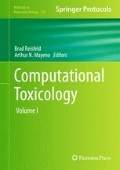Abstract
When analyzing pharmacokinetic data, one generally employs either model fitting using nonlinear regression analysis or non-compartmental analysis techniques (NCA). The method one actually employs depends on what is required from the analysis. If the primary requirement is to determine the degree of exposure following administration of a drug (such as AUC), and perhaps the drug’s associated pharmacokinetic parameters, such as clearance, elimination half-life, T max, C max, etc., then NCA is generally the preferred methodology to use in that it requires fewer assumptions than model-based approaches. In this chapter we cover NCA methodologies, which utilize application of the trapezoidal rule for measurements of the area under the plasma concentration–time curve. This method, which generally applies to first-order (linear) models (although it is often used to assess if a drug’s pharmacokinetics are nonlinear when several dose levels are administered), has few underlying assumptions and can readily be automated.
In addition, because sparse data sampling methods are often utilized in toxicokinetic (TK) studies, NCA methodology appropriate for sparse data is also discussed.
Access this chapter
Tax calculation will be finalised at checkout
Purchases are for personal use only
References
Gabrielsson J, Weiner D (2006) Pharmacokinetic and pharmacodynamic data analysis: concepts and applications, 4th edn. Swedish Pharmaceutical Press, Stockholm
Nakashima E, Benet LZ (1988) General treatment of mean residence time, clearance and volume parameters in linear mamillary models with elimination from any compartment. J Pharmacokinet Biopharm 16:475
Nakashima E, Benet LZ (1989) An integrated approach to pharmacokinetic analysis for linear mammillary systems in which input and exit may occur in/from any compartment. J Pharmacokinet Biopharm 17:673
Bailer AJ (1988) Testing for the equality of area under the curve when using destructive measurement techniques. J Pharmacokinet Biopharm 16:303
Yeh C (1990) Estimation and significance tests of area under the curve derived from incomplete blood sampling. In: ASA Proceedings of the Biopharmaceutical Section, p 4
Nedelman JR, Jia X (1998) An extension of Satterthwaite’s approximation applied to pharmacokinetics. J Biopharm Stat 8(2):317
Hing JP, Woolfrey SG, Wright PMC (2001) Analysis of toxicokinetic data using NONMEM: impact of quantification limit and replacement strategies for censored data. J Pharmacokinet Pharmacodyn 28(5):465
Benet LZ (1972) General treatment of linear mammillary models with elimination from any compartment as used in pharmacokinetics. J Pharm Sci 61:536
Benet LZ, Galeazzi RL (1979) Noncompartmental determination of the steady-state volume of distribution. J Pharm Sci 48:1071
Gibaldi M, Perrier D (1982) Pharmacokinetics. Revised and expanded, 2nd edn. Marcel Dekker Inc., New York, NY
Jusko WJ (1992) Guidelines for collection and analysis of pharmacokinetic data. In: Evans WE, Schentag JJ, Jusko WJ (eds) Applied pharmacokinetics: principles of therapeutic drug monitoring, 3rd edn. Applied Therapeutics, Spokane, WA
Rowland M, Tozer T (2010) Clinical pharmacokinetics and pharmacodynamics: concepts and applications, 4th edn. Lippincott Williams & Wilkins, Maryland
Houston JB (1994) Kinetics of disposition of xenobiotics and their metabolites. Drug Metab Drug Interact 6:47
Pang KS (1985) A review of metabolic kinetics. J Pharmacokinet Biopharm 13(6):633
Watari N, Benet LZ (1989) Determination of mean input time, mean residence time, and steady-state volume of distribution with multiple drug inputs. J Pharmacokinet Biopharm 17(1):593
Gillespie WR (1991) Noncompartmental versus compartmental modeling in clinical pharmacokinetics. Clin Pharmacokinet 20:253
Author information
Authors and Affiliations
Corresponding author
Editor information
Editors and Affiliations
Rights and permissions
Copyright information
© 2012 Springer Science+Business Media, LLC
About this protocol
Cite this protocol
Gabrielsson, J., Weiner, D. (2012). Non-compartmental Analysis. In: Reisfeld, B., Mayeno, A. (eds) Computational Toxicology. Methods in Molecular Biology, vol 929. Humana Press, Totowa, NJ. https://doi.org/10.1007/978-1-62703-050-2_16
Download citation
DOI: https://doi.org/10.1007/978-1-62703-050-2_16
Published:
Publisher Name: Humana Press, Totowa, NJ
Print ISBN: 978-1-62703-049-6
Online ISBN: 978-1-62703-050-2
eBook Packages: Springer Protocols

